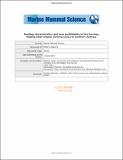Feeding characteristics and prey profitability in five herring-feeding killer whales (Orcinus orca) in northern Norway
Abstract
This study used multisensory data tags with integrated 4K video to investigate feeding behavior and prey profitability in five adult male killer whales (Orcinus orca) at herring wintering grounds in Norway, in 2016 and 2017. Video recorded two killer whales engaged in carousel feeding, and two engaged in seiner feeding (i.e., feeding on herring discards around purse seiner vessels). The feeding behaviors identified from the video data allowed for determination of associated kinematic signatures, which were used to further identify and characterize carousel feeding and deep feeding dives over the entire logger duration. Prey consumption during on camera feeding bouts was also measured to calculate profitability of feeding bouts for the different behaviors. Average number of prey consumed per minute was 1.08±0.43 for carousel feeding and 0.43±0.07 for seiner feeding (n = 122 prey capture events). Using kinematic data, a total of 18 carousel feeding bouts and 206 deep feeding dives were identified. Whales spent at least 37%-65% of time over 24-hr feeding. Using field metabolic rate estimates from the literature and the energetic content of herring caught locally, killer whales required an estimated 285-578 herring/day to balance daily energy requirements.
Citation
Matika , A F , Jourdain , E , Cade , D E , Karoliussen , R & Hammond , P S 2022 , ' Feeding characteristics and prey profitability in five herring-feeding killer whales ( Orcinus orca ) in northern Norway ' , Marine Mammal Science , vol. 38 , no. 4 , pp. 1409-1424 . https://doi.org/10.1111/mms.12931
Publication
Marine Mammal Science
Status
Peer reviewed
ISSN
0824-0469Type
Journal article
Description
Funding: Tagging was conducted as part of the making of the BBC television series Blue Planet II and under permit FOTS ID10176 granted by Mattilsynet to Norwegian Orca Survey. Fieldwork was supported by grants from the Sea World and Busch Gardens Conservation fund and Sea World and Parks Entertainment.Collections
Items in the St Andrews Research Repository are protected by copyright, with all rights reserved, unless otherwise indicated.

